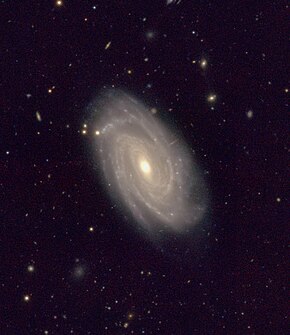| NGC 10 | |
|---|---|
 NGC 10 ESO KIDS | |
| Observation data (J2000 epoch) | |
| Constellation | Sculptor |
| Right ascension | 00h 08m 34.53660s[1] |
| Declination | −33° 51′ 30.1884″[1] |
| Redshift | 0.022719±0.000033[2] |
| Heliocentric radial velocity | 6,811±10 km/s[2] |
| Distance | 346.3 Mly (106.17 Mpc)[3] |
| Apparent magnitude (V) | 13.3 |
| Absolute magnitude (V) | −21.55 |
| Characteristics | |
| Type | SAB(rs)bc[4] or SBbc[5] |
| Apparent size (V) | 1.373′ × 0.879′[6] |
| Other designations | |
| PGC 634,[5] ESO 349-32, MCG-06-01-024[7] | |
NGC 10 is a spiral galaxy located in the southern constellation of Sculptor. It was discovered by John Herschel on 25 September 1834.[8] The galaxy is located at a distance of 346 Mly from the Sun.[3] Its morphological classification in the De Vaucouleurs system is SAB(rs)bc,[4] where the 'SAB' denotes a weak-barred spiral, '(rs)' indicates a slight ring-like structure, and 'bc' means the spiral arms are moderately to loosely wound.[9] Paturel et al. (2003) assigned this galaxy a classification of SBbc, indicating a barred spiral galaxy.[5]
On 22 December 2011, a Type II supernova designated SN 2011jo was discovered in NGC 10 by Stuart Parker of New Zealand. It was located 2″ east and 16″ north of the galactic nucleus.[10]
See also[edit]
References[edit]
- ^ a b Brown, A. G. A.; et al. (Gaia collaboration) (August 2018). "Gaia Data Release 2: Summary of the contents and survey properties". Astronomy & Astrophysics. 616. A1. arXiv:1804.09365. Bibcode:2018A&A...616A...1G. doi:10.1051/0004-6361/201833051. Gaia DR2 record for this source at VizieR.
- ^ a b Mathewson, D. S.; et al. (August 1992). "A Southern Sky Survey of the Peculiar Velocities of 1355 Spiral Galaxies". Astrophysical Journal Supplement. 81: 413. Bibcode:1992ApJS...81..413M. doi:10.1086/191700.
- ^ a b Tully, R. Brent; et al. (2016). "Cosmicflows-3". The Astronomical Journal. 152 (2): 50. arXiv:1605.01765. Bibcode:2016AJ....152...50T. doi:10.3847/0004-6256/152/2/50. S2CID 250737862.
- ^ a b de Vaucouleurs, G.; et al. (1991). "Third reference catalogue of bright galaxies". 9. New York: Springer-Verlag.
{{cite journal}}: Cite journal requires|journal=(help) - ^ a b c Paturel, G.; et al. (December 2003), "HYPERLEDA. I. Identification and designation of galaxies", Astronomy and Astrophysics, 412: 45–55, Bibcode:2003A&A...412...45P, doi:10.1051/0004-6361:20031411.
- ^ Skrutskie, Michael F.; Cutri, Roc M.; Stiening, Rae; Weinberg, Martin D.; Schneider, Stephen E.; Carpenter, John M.; Beichman, Charles A.; Capps, Richard W.; Chester, Thomas; Elias, Jonathan H.; Huchra, John P.; Liebert, James W.; Lonsdale, Carol J.; Monet, David G.; Price, Stephan; Seitzer, Patrick; Jarrett, Thomas H.; Kirkpatrick, J. Davy; Gizis, John E.; Howard, Elizabeth V.; Evans, Tracey E.; Fowler, John W.; Fullmer, Linda; Hurt, Robert L.; Light, Robert M.; Kopan, Eugene L.; Marsh, Kenneth A.; McCallon, Howard L.; Tam, Robert; Van Dyk, Schuyler D.; Wheelock, Sherry L. (1 February 2006). "The Two Micron All Sky Survey (2MASS)". The Astronomical Journal. 131 (2): 1163–1183. Bibcode:2006AJ....131.1163S. doi:10.1086/498708. ISSN 0004-6256. S2CID 18913331.
- ^ "NGC 10". SIMBAD. Centre de données astronomiques de Strasbourg. Retrieved 16 January 2017.
- ^ "New General Catalog Objects: NGC 1 - 49". cseligman.com. Retrieved 2017-11-22.
- ^ de Vaucouleurs, Gérard (April 1963). "Revised Classification of 1500 Bright Galaxies". Astrophysical Journal Supplement. 8: 31. Bibcode:1963ApJS....8...31D. doi:10.1086/190084.
- ^ Bock, G.; Parker, S. (December 2011). "Supernova 2011jo in NGC 10 = PSN J00083457-3351148". Central Bureau Electronic Telegrams. 2964: 1. Bibcode:2011CBET.2964....1B.
External links[edit]
- NGC 10 on WikiSky: DSS2, SDSS, GALEX, IRAS, Hydrogen α, X-Ray, Astrophoto, Sky Map, Articles and images
- "Distance Results for NGC 0010". NASA/IPAC Extragalactic Database. Retrieved 2010-05-03.
- SEDS
Well, that’s interesting to know that Psilotum nudum are known as whisk ferns. Psilotum nudum is the commoner species of the two. While the P. flaccidum is a rare species and is found in the tropical islands. Both the species are usually epiphytic in habit and grow upon tree ferns. These species may also be terrestrial and grow in humus or in the crevices of the rocks.
View the detailed Guide of Psilotum nudum: Detailed Study Of Psilotum Nudum (Whisk Fern), Classification, Anatomy, Reproduction